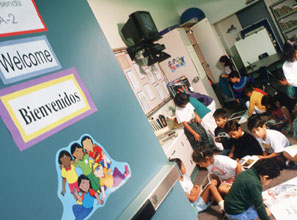

04/30/2012

The article linked below has the usual dreary statistics about the failure of Hispanics to graduate from high school, a basic measure of educational assimilation. The report being reviewed is specific to Arizona, but theres no reason to think the cultural norm of disinterest in school among Hispanic kids isnt pretty universal.
After all, about half of Hispanics drop out of high school and only 13 percent have a college degree. In comparison, 50 percent of Asians residing in the US have a bachelors degree or better.
But wait a minute didnt Pew Hispanic report a near-miraculous uptick in Hispanics enrolled in college not long ago?
Yes. In fact, the Pew researchers found a surge of 24 percent from 2009 to 2010: Hispanic College Enrollment Spikes, Narrowing Gaps with Other Groups. The Pew report credited rising educational attainment as the main factor for the improvement, which doesnt fit with other reports, such as the Arizona data. A substantial portion (46%) of students were attending two-year community colleges, which may explain a little.
Whats going on? Elsewhere Obama has doubled funding for Pell Grants and has ads bragging that he has helped nearly 2 million Hispanic students pay for college.
Are the Hispanic kids getting taxpayer funding to major in easy subjects like Chicano studies or basket-weaving to make Obamas numbers look good? The press cheerfully reports increased enrollment of diverse persons, but it often is not curious about graduation rates and other measures of educational success.
Its all a little odd.
Heres the Arizona report:
Report sounds warning on Latino education gap, Tucson Citizen, April 27, 2012
A new report says Arizona hasnt made much progress in closing the educational-achievement gap for Latinos in the past decade, and it predicts dire consequences to the states economy if nothing changes.
Despite various efforts to improve education, Latinos in Arizona score lower on state standardized tests than White students, have higher dropout rates and are less likely to get a bachelors degree, according to a report released Friday by Arizona State Universitys Morrison Institute for Public Policy.
One example of how the educational-achievement gap has changed little in the past 10 years: The percentage of Latinos ages 25 to 34 who had a bachelors degree or higher increased only 1 percentage point to a total of 9 percent, compared with 32 percent for Whites.
The study, titled Dropped? Latino Education and Arizonas Economic Future, comes 10 years after the institute issued a similar report that was considered a warning and a call to action. The latest report predicts that the failure to close the achievement gap poses a grave threat to the states economic health. The key reason is that Latinos are expected to make up a majority of Arizonas population and wage earners in the future.
The report was unveiled at a morning session in Phoenix attended by more than 150 community and business leaders, educators and state legislators. The report was followed by a question-and-answer session on possible solutions with a panel of business leaders and educators.
Organizers hope the report will renew the call to action that was made a decade ago.
The fact is things can be done, and its up to us, Paul Luna, CEO and president of Helios Education Foundation, a non-profit that provided funding for the study along with the Virginia G. Piper Charitable Trust, told the audience.
The 40-page report cites statistics that show Latinos make up nearly one-third of the states population and about 47 percent of its children under 19. They are likely to become the majority within two decades.
At the same time, a postsecondary education and work skills are becoming more important to earn a living. By 2018, an estimated 61 percent of all the jobs in the state will require some training beyond high school, according to the Georgetown University Center on Education and the Workforce.
Without an education beyond high school, a growing number of families will likely have lower incomes. That means less purchasing power, the Morrison Institute study says, which will lower tax revenue and inhibit economic growth. Less tax revenue strains public services as well.
Doug Pruitt, retired chairman and CEO of Sundt Construction and a panelist at Fridays discussion, predicted Arizona was headed in the direction of a social-welfare state if nothing changes. A state populations general level of education is one factor companies consider when deciding whether to locate in a state. Companies are going to avoid Arizona if there arent enough skilled workers for their businesses, he said.
Theyre not going to take the risk to invest in a state and then pray that you may get your education system in order, he said.
Pruitt said different education expectations have to be set for todays young people. Instead of assuming everyone needs a four-year college degree, he said, vocational education should also be emphasized.
Its not just an education, he said. Its an education and a skill.
Despite the reports dire predictions, there are some bright spots, panelists said.
The Maricopa Community College District, one of the largest community-college systems in the country, is educating a growing number of Latino students, said Maria Harper-Marinick, the districts executive vice chancellor and provost. Community colleges and state universities are working more closely together to increase the number of students who transfer to the universities and get four-year degrees.
Harper-Marinick said that solutions for closing the achievement gap are not simple and that funding needs to be part of the conversation.
A lot of the ideas that we have take money, she said. Thats just reality.
Another panelist, Phil Francis, retired CEO of PetSmart, said he was encouraged by the number of educational-advocacy groups in the state that have been able to start and sustain reforms.
He suggested that what the state needs is a single-mindedness, rather than a well-intended, piecemeal approach, or fragmented bills in the state Legislature.
We need to create a movement and get deadly serious, he said.